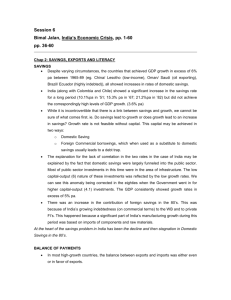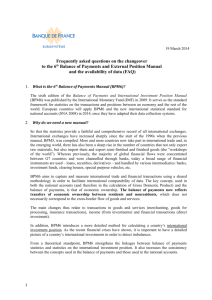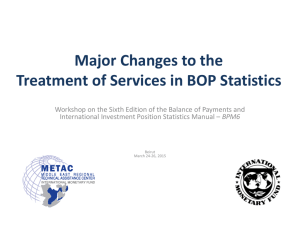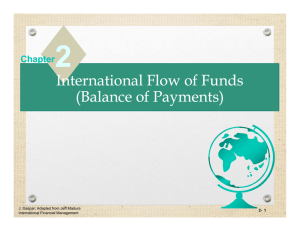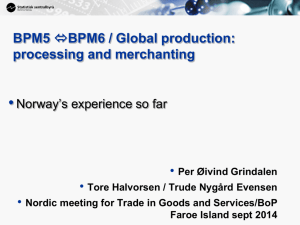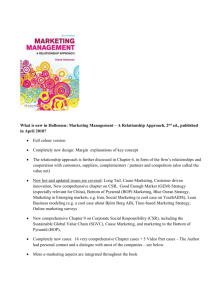BPM6 - United Nations Economic Commission for Europe
advertisement
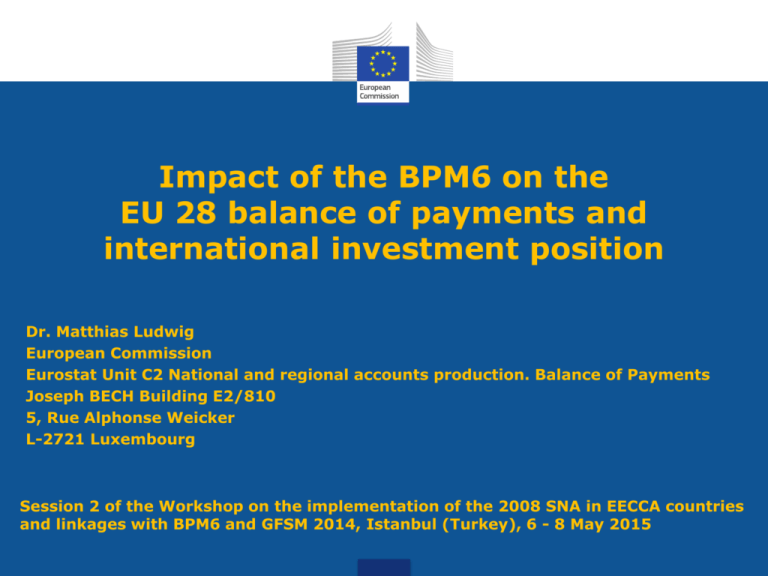
Impact of the BPM6 on the EU 28 balance of payments and international investment position Dr. Matthias Ludwig European Commission Eurostat Unit C2 National and regional accounts production. Balance of Payments Joseph BECH Building E2/810 5, Rue Alphonse Weicker L-2721 Luxembourg Session 2 of the Workshop on the implementation of the 2008 SNA in EECCA countries and linkages with BPM6 and GFSM 2014, Istanbul (Turkey), 6 - 8 May 2015 Outline B.o.p. and i.i.p. statistics compiled by Eurostat and their importance in EU policy making • Most relevant changes introduced by the BPM6 from the Eurostat perspective – Methodological changes; – New treatment of transactions and positions. • Commission Regulation (EU) No 555/2012 of 22 June 2012 and ECB Guideline 23/2011 of 9 December 2011. 2 EU policy making National b.o.p. and i.i.p. are – among others - used to: • monitor the divergence in competitiveness (ECB and European Commission); • detect macroeconomic imbalances (European Commission): Current account balance, net i.i.p., %-change of export market shares are 3 out of the 11 headline indicators of the MIP Scoreboard. • Other relevant indicators are: current and capital • account balance, net interest payments and net • external debt. 3 Eurostat 5 Eurostat Eurostat indicators: Importance of goods and services in current account Eurostat Balance of Payments and International Investment Position Manual Framework for statistics on transactions and positions between an economy and the rest of the world. Reasons for a new Manual: • Globalization and financial innovation; • Increase the emphasis on IIP; • Harmonisation with other macroeconomic statistics. The BPM6 provides more explanations and definitions of topics. 7 Major changes in terminology BPM6 BPM5 Headings ‘net acquisition of financial assets’ and ‘net incurrence of liabilities’ ….instead of 'debits' and ‘credits’ Trade credit and advances Trade credits SNA 2008 institutional sector and financial assets/liabilities classifications and nomenclatures are broadly adopted Long-term and short-term debt securities… ... replaced ‘bonds and notes’ and ‘money market instruments’. Charges for the use of intellectual property not included elsewhere … replaces the term ‘royalties and licence fees’. The term ‘personal transfers’ is introduced ...which is broader than the former ‘workers’ remittances’. To increase the consistency vis-à-vis national accounting, several nomenclature changes were introduced: In the BPM6, the terms ‘primary income’ and … replace ‘income’ and ‘current transfers’. 8 Goods: General merchandise BPM6 Chapter 10 Main component of b.o.p. goods: By definition: includes any goods where there is change of ownership between residents and non-residents, with strict application of the change of ownership principle in the BPM6 (processing and repairs are moved to services, while merchanting is added to goods) Source in almost all EU28 Member States (but Greece): International merchandise trade statistics (IMTS). Collected in the Member States of the EU according to Intrastat and Extrastat Regulations. IMTS are based on different concepts than BOP, so adjustments have to be made. 9 EU Customs union: implications for ITGS Intrastat: Coverage: trade between EU Member States in Community goods; Dispatches (exports) – Arrivals (imports): Data source: - Close link with VAT-system; - direct collection of data from trade operators; - Supplemental Declaration; - National reporting thresholds for operators; - Compiled monthly and transmitted to Eurostat within 40 days; - detailed in terms of goods traded (Combined nomenclature CN8: 0902 20 00 Green tea in immediate packings of > 3 kg). Systems to collect ITGS • Extrastat • Coverage: - Statistics on trade with non-EU countries; - Exports and Imports. Data source: - based on customs declarations; - customs procedures; - Copy of Single Administrative Document (SAD); - Compiled monthly and transmitted to Eurostat within 40 days; - detailed in terms of goods traded (CN8). 11 12 Methodological differences between International Trade in Goods Statistics (ITGS) and BOP International Trade in Goods Statistics Coverage & time: when borders are crossed; Valuation: IMTS use FOB-type valuation as the statistical value of exports and CIF-type for imports. Balance of Payments Coverage & time: change of ownership; Valuation: FOB/FOB (BPM6 § 10.30). 13 • ITGS registers both the value of imports and exports at the national border: imports are valued at the border of the importing country (CIF value) and exports at the border of the exporting country (FOB value). 14 Methodological differences between International Trade in Goods Statistics (ITGS) and BOP Main adjustments needed when using ITGS in BOP: • Goods that change ownership without crossing borders, or goods that cross borders, but do not change ownership. • In the national accounts and b.o.p., both imports and exports are valued on a FOB basis (i.e. at the border of the exporting country). This means that the ITG value of imports needs to be adjusted from CIF to FOB value. 15 Adjusting Intastat and Extrastat data Exports/Credits and Imports/Debits Examples of items to be removed: • Goods sent abroad for processing or returned after processing; • Only for imports: the value of the CIF/FOB adjustment. Examples of items to be added: • Goods in customs warehouses; • Goods imported/exported illegally. 16 The EU reconciliation tables, regularly compiled as Annex of the BOP Quality Report • Example: Luxembourg BOP Quality Report, publicly available in the internet, download under: • http://www.statistiques.public.lu/en/methodology/methodes/ec onomy-finances/bop/bop/index.html • http://www.statistiques.public.lu/fr/methodologie/methodes/ec onomie-finances/Bop/bop/qualite2011.pdf 17 1. “Goods” as published by Eurostat FTS in The EU reconciliation tables, million Euro regularly compiled 2.as part of BoP ITGS figure used by BOP compilers in million Euro * Quality Report of which (=including): (1) 2.1 Repairs of goods (gross value) 2.2 Goods for processing (gross value) D0 - Differences between 1. and 2. D1 - Differences between point 1. and point 2. explained by: (NB: it should be D0=D1) 2.1.1 Use of settlements information 2.1.2 Revision vintages 2.1.3 Others (please specify) …. …. 3. Adjustments made to ITGS data for BOP purposes in million Euro http://www.statistiques.public.lu/fr/methodologie/metho des/economie-finances/Bop/bop/qualite2011.pdf 18 Current account (BPM5) Current account (BPM6) Goods and services Goods and services Trade balance ( Goods) Goods General merchandise General merchandise on a BOP basis Net exports of goods under merchanting (credit) Goods for processing Repairs on goods Services Services Other services Net exports of goods under merchanting Other services Manufactoring services on physical inputs FISIM Income Compensation of employees Investment income FISIM Current transfers Workers' remittances Capital and financial account Maintenance and repair services n.i.e. Primary income compensation of employees Investment income Other primary income Secondary income Personal transfers Financial account Capital account1 Capital account1 Financial account Change in reserve assets Reserve assets 19 Changes in the current accounts Current account: Goods, services, primary income (new – income on reserve assets), secondary income (new – additional breakdown) (BPM5: goods, services, income, current transfers). Goods: Manufacturing service on physical goods owned by others: Processing is defined as manufacturing services on goods that do not belong to the manufacturer. Imputation of change of ownership for goods undergoing processing in BPM5; In BPM6, Goods for processing and Repairs on goods are recorded under Services. 20 Changes in the current account Manufacturing services on physical inputs owned by others: (cont.) The change in the methodology for ‘goods for processing’ may have a significant impact on estimates of goods and services trade for a number of economies. The treatment in BPM6, increase exports or imports of services, and will reduce gross exports and imports of goods. The fee received for the processing services rendered is included in ‘manufacturing services on physical inputs owned by others’. 21 Changes in the current account Net export of goods under merchanting: In BPM5, merchanting was included in ‚merchanting and other trade-related services‘. In BPM6, merchanting of goods is reclassified from services to goods. The purchase of goods is classified as a negative export of goods of the economy of the merchant, and the sale is classified as a positive export of goods, with the difference between sales and purchases recorded in goods exports as ‚net exports of goods under merchanting‘. 22 Manuals for ITGS: from BPM5 and MSITS(2003) to BPM6 and MSITS (2010) BPM and MSITS have common conceptual framework: Manual on Statistics of International Trade in Services (MSITS): • Expands the detail for services introducing the extended • classification: EBOPS (Extended BOP Services • Classification); • Covers also definitions and methodology related to FATS • (Foreign Affiliates Statistics); • Covers also definitions and methodology related to trade • in services by mode of supply, as required by GATS/WTO (crossborder supply, consumption abroad, commercial presence, presence of natural person). 23 Importance of services billion EUR, extra- EU 28 Current account Credit Debit 2011 Balance Credit 2011 2011 Debit 2012 Balance Credit 2012 2012 Debit 2013 2013 2,807 2,848 -41 3,067 2,971 96 612 495 117 677 533 144 694 14 7 7 16 9 7 6 3 3 7 2 133 116 17 142 Services: Travel 86 88 -1 Services: Construction 10 5 Services: Insurance and pension services 29 Services: Financial services 62 Services Services: Manufacturing services on physical inputs owned by others Services: Maintenance and repair services n.i.e. Services: Transport Balance Credit 2014 Balance 2014 2014 155 3,073 2,947 127 543 151 735 583 151 16 8 8 19 7 12 4 9 7 1 10 7 3 122 20 140 125 15 136 123 13 97 91 6 103 90 14 107 96 12 6 11 5 6 14 5 9 14 5 9 12 17 31 12 20 30 11 18 33 14 19 26 36 70 29 41 75 31 44 75 34 42 0 59 27 33 60 29 30 0 16 4 12 16 4 11 Services: Financial services explicitly charged and other financial services 3,051 2,896 2013 Debit Services: FISIM Services: Charges for the use of intellectual property n.i.e. 38 55 -16 40 59 -19 41 60 -18 48 80 -32 Services: Telecommunications, computer, and information services 58 29 29 65 32 34 70 35 35 77 36 41 145 130 15 165 148 17 177 155 22 200 166 34 21 19 1 24 22 2 27 26 1 29 29 0 Services: Other business services Services: R & D services Transport Classification by mode of transport: sea, air, other • Other: rail, road, internal waterway, pipeline, space, electricity transmission; • Who/what is carried: passengers, freight, other; • Postal and courier services included as separate item of Transport (BPM5: communication services). 25 Travel Travel covers assortment of goods and services: • for own use or to give away; • acquired from an economy by nonresidents; • during visits to that economy (demand moves); • covers stays of any length provided no change of • residency (students, patients). BPM6: durable goods (e.g. cars) and valuables (art, jewelry) that are included in customs data are not included in Travel but in Goods. 26 Construction Creation, renovation, repair, or extension of fixed assets: • building, roads, bridges, dams; • related installation and assembly work; • site preparation and general construction as well a specialized services; management of construction projects. Substantial projects (1 year or more) may constitute a branch resident in the economy of operations: foreign direct investment between parent and branch. 27 Construction Construction abroad; construction in the reporting economy Recorded on gross basis: all costs of construction work, inputs (if acquired by the construction company), and profit (surplus) Example construction abroad: • Credit: value of the construction project abroad: 100 • Debit: costs of goods purchased from the economy of construction work: 75 • Net export construction services (abroad): 25 28 Insurance services Insurance services include: • life insurance and annuities; • non-life insurance (e.g. accident and health, fire and other • property damage, general liability); • reinsurance (both parties to the policy are providers of • insurance services); • freight insurance (rerouting due to FOB valuation); • pension funds (i.e. not social security); • standardized guarantees (e.g. export credit and student • loan guarantees); • auxiliary services. 29 Financial Services FISIM Financial Intermediation Services Indirectly Measured • Financial intermediaries offer rates of interest to their depositors that are lower than the rates that they charge to their borrowers. • The resulting interest margin is used to cover expenses and to provide an operating surplus. • Interest margins are an alternative to explicit service fee. 30 Financial Services Financial Intermediation Services Indirectly Measured (FISIM) Actual interest includes element of income as well as charge for service; By convention, only arises from loans and deposits where both parties are financial corporations; Loans from financial corporations - difference between interest actually payable and the amount payable if reference rate were used; Deposits – difference between the interest that would be earned if reference rate were used and interest actually earned; Included in services (not income). 31 Other Business Services Research and development services • Basic/applied research; experimental development; commercial research; • Sale of results from R&D (patents, copyrights) (BPM5: capital account); • Excluded: fees for use of R&D results (Charges for the use of intellectual property). Professional and management consulting services • Legal, accounting, PR, consulting service; • Advertising, market research, call centres; • Fees for general management of subsidiaries. 32 Other Business Services Technical, trade-related, and other business services • Architectural, engineering; mining and waste treatment; operating leasing (excl: transport equipment with crew); commissions on goods/services transactions payable to merchants; placement of personnel, security & cleaning, translation, real estate services. 33 Primary income Income associated with production: • Compensation of employees; • Taxes and subsidies on products and production. Property income • Investment income = financial assets; • Rent = land, natural resources. 34 Compensation of employees Requires an employer-employee relationship between a resident and a non-resident and includes: • wages and salaries in cash; • wages and salaries in kind (meals, transport, holidays/sport facilities, loans at reduced interest, etc.); • employers’ social contributions. 35 Compensation of employees Examples: - cross border workers - seasonal/short term workers - Nonresident domestic helpers (<1 year) - local staff in embassies/military bases - staff of international organisations Remark: Compensation of employees ≠ workers’ remittances 36 Secondary income account Resembles BPM5 current transfers items. Each transaction is either exchange or transfer Exchange: the provision of economic value against receiving economic value. When economic value (say goods) is provided without anything in return, the counterpart entry is a transfer. A transfer is an entry that offsets the provision of an economic value (good, service, financial asset, or other nonproduced asset) without a counterpart return of an item of economic value. A transfer can be current or capital. 37 Current vs capital transfers Current transfers consist of all transfers that are not capital transfers Capital transfers are transfers in which: - the ownership of an asset (other than cash or inventories, i.e. fixed assets, valuables, or nonproduced assets) is transferred; or which - obliges one or both parties to acquire or dispose of an asset (other than cash or inventories, i.e. investment grant); or where - a liability is forgiven by the creditor. A capital transfer results in a commensurate change in the stocks of assets of one or both parties to the transaction without affecting the saving of either party. 38 Capital account Acquisition of non-produced, non-financial assets - Natural resources; - Contracts, leases and licenses; - Marketing assets and goodwill. Capital transfers - Debt forgiveness; - Nonlife insurance claims; - Investment grants; - BPM6 Excludes migrant effects (other changes in • volume), sale of patents (R&D service). 39 Non-produced assets: Natural resources Included are: - land if not included in FDI (enclaves for embassies and international organisations); - mineral rights; - forestry rights; - water; - fishing rights; - air space; - electromagnetic spectrum. 40 Non-produced assets: Contracts, leases and licenses Includes contracts/leases/licenses recognized as economic (intangible) assets (e.g. transfer fees for a football player, entitlements to purchase goods on exclusive basis, emission permits that are tradable etc.) Intangible assets are not created in a production process; excluded are for instance: Transfer of ownership or use of intellectual products (software rights, copyrights, patents) if outright sale recorded in R&D services, if temporary use Service Charges for use of intellectual property 41 Non-produced assets: Marketing assets - Acquisitions/sales of brand names, mastheads, trademarks, logos, domain names; - Only when sold separately from the entity that owns them; - Fee for domain registration, logo design is service; - Goodwill in BOP is not traded separately from ownership of an enterprise. 42 Capital transfers - Debt forgiveness is the voluntary cancellation of all or part of a debt within a contractual agreement between a creditor and a debtor (write-off recorded as other flow). - Exceptional non-life insurance claims related to major catastrophes may be recorded as capital transfers; - Investment grants; - Activation of one-off guarantees and other debt assumption; - Taxes levied at irregular intervals, like capital levies and inheritance taxes; - Other capital transfers (major compensation payments not covered by insurance). 43 Thank you for your kind attention Matthias.ludwig@ec.europa.eu
